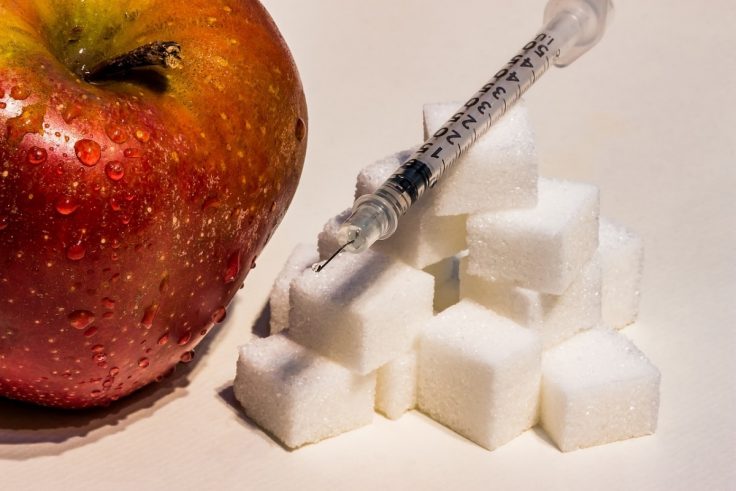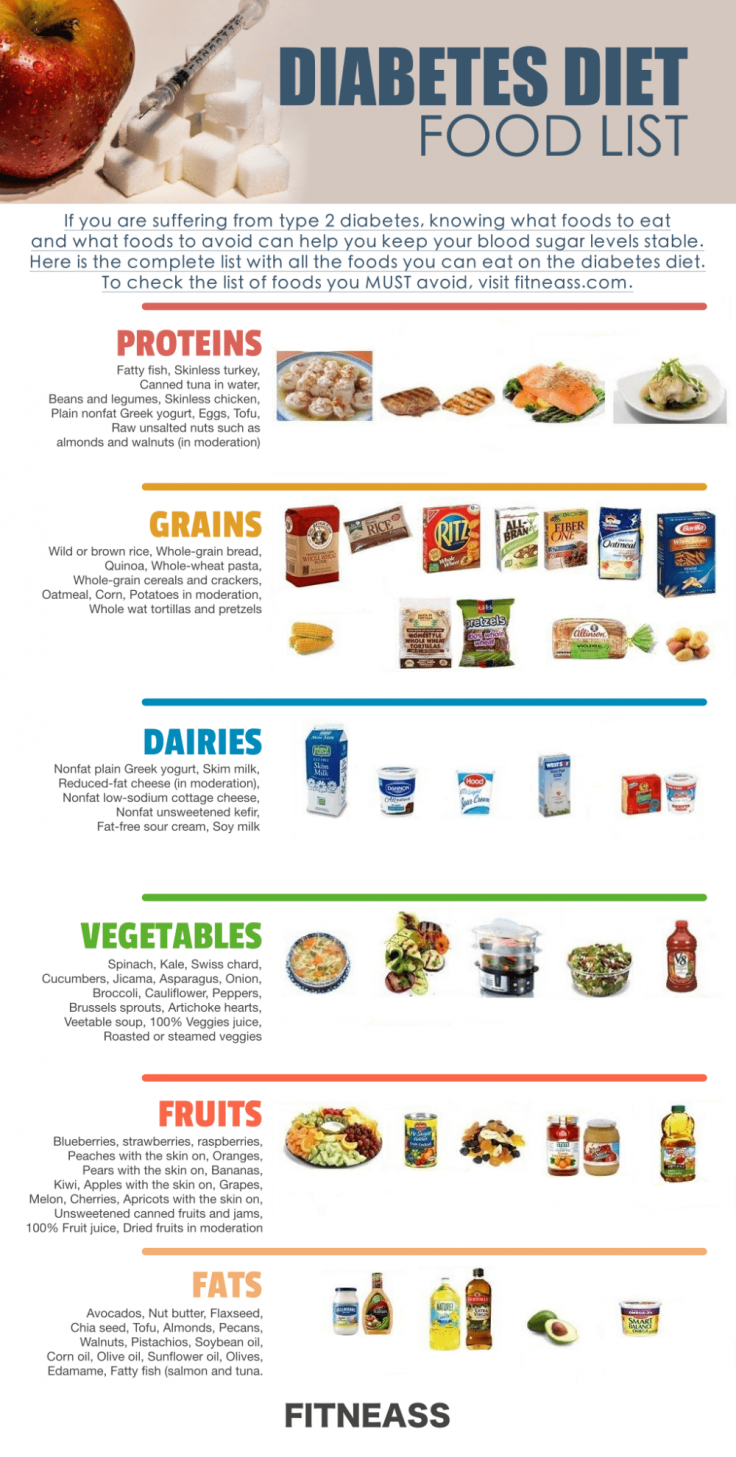The Complete Food List For The Type 2 Diabetes Diet

This is a complete list of all the foods you want to avoid and those you should focus on when you’re following a diabetes diet.
If you are suffering from type 2 diabetes, knowing what foods to eat and what foods to avoid can help you keep your blood sugar levels stable.
Don’t panic if you don’t know what foods work for your diabetes because here you will find everything you need to know.
A good diabetes diet is what you need to help maintain your blood sugar levels and even reverse diabetes in some cases.
A type 2 diabetes diet doesn’t mean you have to give up good food. You will still be able to enjoy a wide range of foods that will help you with your disease and, in rare cases, even reverse type 2 diabetes.
Type 2 diabetes diets are all about balance. You need to include in your diet the right amount of fats and proteins and a variety of healthy carbohydrates.
The idea behind a good diabetes diet is to help you to avoid common diabetes symptoms such as:
- Frequent urination;
- Fatigue;
- Headaches;
- Dizziness;
- Low blood sugar (hypoglycemia).
The Type 2 Diabetes Diet
The key to following this healthy diabetes diet is for you to understand how certain foods can affect your blood sugar.
Carbohydrates will raise your blood sugar and can even lead to hyperglycemia. This is because carbohydrates are broken down in glucose faster than any other type of food. You can find carbohydrates in pasta, milk, sweets, bread, starchy vegetables, and grains.
The fats and proteins do not directly affect blood sugar levels but are good to consume in moderation to keep your weight and nutrient intake in a healthy range.
So to keep your blood sugar level in balance, you need to eat a variety of foods but with careful monitoring when it comes to carbohydrates.
Now let’s see exactly what foods a diabetes diet should promote, and what foods should avoid.
1. How To Count Carbs
You can calculate the right amount of carbs you need in your diet by figuring out what percentage of your diet should be made up of carbohydrates.
According to experts, this number should be somewhere between 45 and 65% of your total calories. But if you have diabetes this number should be lower than that percentage and always stay lower.
To understand this better here is an example:
If you want to get 50% of your calories from your carbs and you consume 2000 calories a day, you are aiming for 1000 calories from carbs. This means 250 grams of carbs.
That is because 1 gram of carbs provides you with 4 calories. You can divide the number of calories from carbs by 4 and you get your daily target of grams of carbs, which in this example is 250.
To get this more personalized you can work with a certified diabetes educator to determine a goal that is best for you.
2. Best And Worst Food Groups For Type 2 Diabetes
When you pick your foods for your type 2 diabetes diet you should fill half your plate with nonstarchy veggies and the rest of your plate with healthy choices.
Healthy choices include lean protein, seeds, nuts, whole grains, fat-free or low-fat dairy, and healthy fats and fresh fruits.
You should limit your processed carbohydrates and sugar, and this includes soda, processed snacks, and candies.
Artificial sweeteners you can find in diet soda won’t necessarily influence your blood sugar in the same way. They can still have an effect on your blood sugar level and can alter your body’s insulin response. But to confirm this, more research is needed.
3. High Protein Foods For Type 2 Diabetes
For people that have diabetes, experts recommend lean protein low in saturated fats.
For those who are following a vegetarian or vegan diet can be challenging to get the right kind and amount of protein in their diet. But a really good option for substituting meat and getting the protein they need can be tofu, nuts, and beans. Just make sure to portion your nuts as they are high in calories and fat.
On this diabetes diet, you should avoid or at least limit the consumption of processed and packed foods because they contain processed carbohydrates and added sugar.
Also, processed foods are usually high in sodium, which can increase blood pressure, the risk of stroke, and heart disease. All of these are complications of type 2 diabetes.
Including protein-rich foods in your diet will keep you satiated, can help you with losing weight, and can reduce insulin resistance.
The best protein options for type 2 diabetes are:
- Fatty fish;
- Skinless turkey;
- Canned tuna in water;
- Beans and legumes;
- Skinless chicken;
- Plain, nonfat Greek yogurt;
- Raw, unsalted nuts, such as almonds and walnuts (in moderation);
- Eggs;
- Tofu.
Now, the worst high-protein foods you can eat while on a diabetes diet are:
- Hot dogs;
- All sorts of deli meats, such as salami, bologna, ham, turkey, and roast beef;
- Beef jerky;
- Sweetened or flavored nuts, like honey-roasted or spicy;
- Sausages and pepperoni;
- Sweetened protein shakes or smoothies;
- Bacon.
4. Grains For Type 2 Diabetes
Not all carbs are bad when you’re trying to manage diabetes. In fact, you should consume vitamin-rich whole grains that contain fibers to aid your digestion.
Fibers can also make you feel fuller which will prevent you from craving unhealthy snacks, so make sure to research the best bedtime snacks for diabetics.
To avoid unwanted blood sugar spikes you should stay away from grains you can find in popular foods. This means you need to avoid or at least limit the consumption of white bread, and processed or packed grains.
Refined white flour is also something you should consider cutting out from your diet. It doesn’t contain the same fibers, vitamins, minerals, and health benefits as whole grains.
Here are the best grain options you can consume in moderation during the diabetes diet:
- Wild or brown rice;
- Whole-grain bread, such as 100% whole-wheat bread;
- Quinoa;
- Whole-wheat pasta;
- Whole-grain cereals, such as steel-cut oats.
Now let’s take a look over the types of grain you should avoid:
- White bread;
- Sugary breakfast cereals;
- White rice;
- Pastries;
- White pasta.
5. Dairy For The Diabetes Diet
When you’re following a diabetes diet you need to pay attention to the amount and quality of the dairy you consume.
High-fat dairy can lead to obesity, which can reduce insulin sensitivity, causing prediabetes that will eventually lead to diabetes.
And if you already have type 2 diabetes and consume high-fat dairy, you will increase the risk of severe complications.
All you need to do to avoid unhealthy saturated fats and those extra calories is to choose fat-free dairy products. And the best options are:
- Nonfat plain Greek yogurt;
- Skim milk;
- Reduced-fat cheese (in moderation);
- Nonfat, low-sodium cottage cheese;
- Nonfat, unsweetened kefir.
Any kind of full-fat dairy is a dangerous option for a diabetic person.
6. Vegetables For Type 2 Diabetes
Vegetables should be included in any healthy diet, including a diabetes diet.
The only thing you should consider when you want to add veggies to a diabetes diet is to make sure you choose nonstarchy vegetables. They are low in carbohydrates which is perfect if you want to keep your blood sugar level under control.
Packed, frozen veggies are as good as the fresh ones. You can even opt for canned ones if they are low in sodium.
Here is a list with the best nonstarchy veggies you can consume during the diabetes diet:
- Greens, like spinach, kale, and Swiss chard;
- Cucumbers;
- Cruciferous veggies, like broccoli and cauliflower;
- Jicama;
- Asparagus;
- Onions;
- Brussels sprouts;
- Peppers;
- Artichoke hearts.
Also, there are a few vegetables you should eat in moderation:
- Corn;
- Yams;
- Beets;
- Sweet and white potatoes;
- Peas.
7. Fruits For Type 2 Diabetes
Adding the right fruits to your diet will help you stay away from unhealthy and processed sweets. Also, you will get a boost of vitamins, disease-fighting antioxidants, and satiating fibers.
You have to know that not all fruits and not all products made out of fruits are recommended in the diabetes diet.
Canned fruits can contain excessive sugary syrup which you have to avoid at all costs.
Commercial juices are something you should avoid too. They lack all the beneficial nutrients and fiber you can find in your fruit with the peel on.
Dried fruits aren’t the way to go either. Removing so much water from the fruits will make them less fulfilling for you. For example, two tablespoons of raisins contain the same amount of carbs as a whole apple. So you better opt for the real whole fruit if you want to feel satiated.
You can consume smoothies as long as you don’t add sugar and make them from whole fruits. You can also add nonfat yogurt and nuts to your morning smoothie. This way you’ll help your body to break down the carbs which will lead to less of a spike in your blood sugar.
Here are the most diabetes-friendly foods:
- Berries, like blueberries, strawberries, and raspberries;
- Peaches with the skin on;
- Oranges;
- Pears with the skin on;
- Bananas;
- Kiwi;
- Apples with the skin on;
- Grapes;
- Melon;
- Cherries;
- Apricots with the skin on.
Now, as I’ve mentioned above, the worst fruit options are:
- Dried fruits;
- Fresh juices that are part of fad cleanses;
- Canned fruit in syrup;
- Packaged juices.
8. Fats That Are Good For Diabetics
Getting the right amount of the right kind of fat can help you lose weight, curb your unhealthy cravings, and you can gain better control over your blood sugar.
Consume monounsaturated fats that you can find in almonds, avocados, pecans, and polyunsaturated fats that you can find in walnuts and sunflower oil because they can help you lower your cholesterol, which is what you need if you have type 2 diabetes.
You should avoid saturated fats and trans fats that can be harmful to your health. You can avoid consuming trans fats by checking the labels of your food and ditching everything that contains the term “hydrogenated”.
Here is a list of the best fats that can be consumed during a type 2 diabetes diet:
- Avocados;
- Nut butter;
- Seeds, like flaxseed, and chia seed;
- Tofu;
- Nuts, like almonds, pecans, walnuts, and pistachios;
- Plant-based oils, like soybean oil, corn oil, olive oil, and sunflower oil;
- Olives;
- Edamame;
- Fish, like salmon and tuna.
On the other side, the worst fat options are:
- Any kind of fast food;
- All sorts of packaged snacks, such as potato chips, crackers, and corn chips;
- Full-fat dairy products;
- Beef, veal, lamb, and pork;
- All kinds of processed sweets, such as cookies, doughnuts, muffins, and cakes;
- Coconut and palm oil.
This complete guide on what foods to eat and what to avoid on a diabetes diet should help you prepare healthy options for you or anyone suffering from type 2 diabetes.
And if you feel overwhelmed after processing all this information, don’t worry. There’s a solution for you: diabetic meal kits from renowned food delivery services.
Hopefully, now you know how to eat healthy as a diabetic person. It’s not easy, but it shouldn’t be hard either; especially with all the information you can find online and all these meal delivery services nowadays.

Type 2 Diabetes Diet Complete Food List